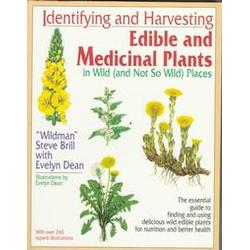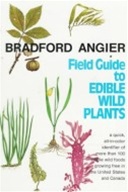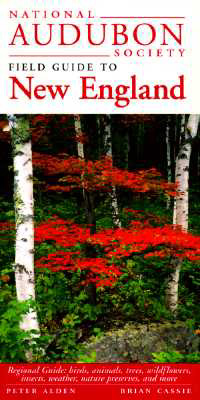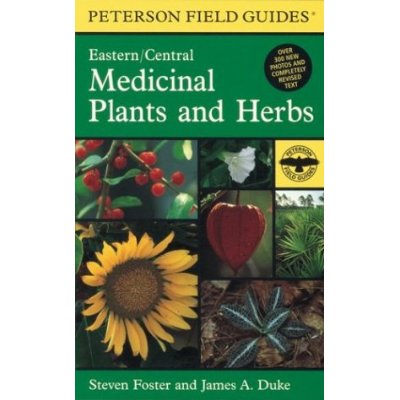You gotta have a bunch of field guides. There are field guides available on just about every subject of nature that you can imagine. I have ones on: bats, animals, rocks and gems, birds, edible plants, medicinal plants, forests, different regions, plants and flowers and wildflowers. The Internet is also a huge resource. I don’t know how we got by before The Googles were born.
When I walk in the fields and woods I’m always looking around, looking up and down. If I see something that looks interesting to me and I don’t know what it is I’ll break off a branch or some leaves and bring it home to identify it. If you do this too then you know that you need to have at least three or four field guides in order to be sure that you identified your subject correctly.
Some field guides will only show a plant when it’s flowering and many plants only flower for a week or two so if you want to identify it the other 50 weeks a year you may be out of luck. Different field guides have different pictures or drawing and different descriptions. That’s why it’s good to have a bunch of field guides, so you can cross reference.
One of my readers, (Yeah, I do have a few.) I thank each and everyone of you, readership is the greatest form of flattery and I don’t ask you to buy my crap either. Someone asked me to tell you what field guides I use so here it comes…
 Identifying and Harvesting Edible and Medicinal Plants is by Wildman Steve Brill. Mr. Brill is the guy that forages and gives classes how to forage Central Park, NYC. Amazing how much wild food there is growing free and wild in Central Park. There aren’t any color pictures in this book. Heck, there aren’t any pictures at all, BUT there are good drawings. This might not be a good first field guide to get, but it is large and the descriptions and uses of plants are great. This guide is organized by season. Mr. Brill is very straightforward he will tell you if a wild plant isn’t worth harvesting. I particularly like some of the history of the plants that he tells the reader about. There is even a section with recipes. It’s 317 pages long and a big book maybe 8 1/2 * 11.
Identifying and Harvesting Edible and Medicinal Plants is by Wildman Steve Brill. Mr. Brill is the guy that forages and gives classes how to forage Central Park, NYC. Amazing how much wild food there is growing free and wild in Central Park. There aren’t any color pictures in this book. Heck, there aren’t any pictures at all, BUT there are good drawings. This might not be a good first field guide to get, but it is large and the descriptions and uses of plants are great. This guide is organized by season. Mr. Brill is very straightforward he will tell you if a wild plant isn’t worth harvesting. I particularly like some of the history of the plants that he tells the reader about. There is even a section with recipes. It’s 317 pages long and a big book maybe 8 1/2 * 11.
 Angiers Field Guide to Edible Wild Plants doesn’t have any pcitures either, but the drawings are in color. This guide is organized alphabetically, which isn’t a lot of help in identifying things, but that’s why you have have to familiarize yourself with all of your field guides, because then when you are walking you will see something that you recognize. There are good descriptions in this book. It is 255 pages long and small enough to put in a pack.
Angiers Field Guide to Edible Wild Plants doesn’t have any pcitures either, but the drawings are in color. This guide is organized alphabetically, which isn’t a lot of help in identifying things, but that’s why you have have to familiarize yourself with all of your field guides, because then when you are walking you will see something that you recognize. There are good descriptions in this book. It is 255 pages long and small enough to put in a pack.
 Guide to Northeastern Wild Edibles by Kavasch has great color photos. I think it’s out of print, but you can get used copies off of the Internet. It is organized by season. It has a handy feature, a ruler markings inside the back cover, not a big deal, but still a great addition. It’s really a good guide. This book is 64 pages and small enough to carry in a pack.
Guide to Northeastern Wild Edibles by Kavasch has great color photos. I think it’s out of print, but you can get used copies off of the Internet. It is organized by season. It has a handy feature, a ruler markings inside the back cover, not a big deal, but still a great addition. It’s really a good guide. This book is 64 pages and small enough to carry in a pack.
 This isn’t so much a field guide on edible plants as it is a general guide to different types of forests in the Eastern US of A, like Boreal, Transition, Deciduous, Oak-Hickory, etc. It’s by the Audubon Society so it’s well written and the many, many color pictures are great. For example, in the tree section there are color pictures of the trees and also drawings of the entire tree outline and the critter section has color pictures and maps to show where the critters reside to help ID them. It’s 635 pages long and kind of big to carry backpacking for a distance. Great for a day pack though because you can really have fun with it because all of the bases are covered: trees, birds, mammals, snakes, insects and spiders, mushrooms, wildflowers, butterflies and moths and amphibians.
This isn’t so much a field guide on edible plants as it is a general guide to different types of forests in the Eastern US of A, like Boreal, Transition, Deciduous, Oak-Hickory, etc. It’s by the Audubon Society so it’s well written and the many, many color pictures are great. For example, in the tree section there are color pictures of the trees and also drawings of the entire tree outline and the critter section has color pictures and maps to show where the critters reside to help ID them. It’s 635 pages long and kind of big to carry backpacking for a distance. Great for a day pack though because you can really have fun with it because all of the bases are covered: trees, birds, mammals, snakes, insects and spiders, mushrooms, wildflowers, butterflies and moths and amphibians.
 Field Guide to New England is another Audubon book. This is a more specialized field guide as it is only for New England. Although, I’m certain that many of the plants also grow near you too. You can really learn alot about your natural surroundings from this book. This book at 447 pages is small enough to pack with you. Not a whole lot of info on edible stuff, but it’s a great all purpose field guide. The pictures are great and there are multiple pictures on every page. it’s broken up by: geology, habitats, conservation and ecology, weather (IDing clouds is pretty cool), the night sky (once again pretty cool), flora, invertebrates, vertebrates, park and preserves of the region.
Field Guide to New England is another Audubon book. This is a more specialized field guide as it is only for New England. Although, I’m certain that many of the plants also grow near you too. You can really learn alot about your natural surroundings from this book. This book at 447 pages is small enough to pack with you. Not a whole lot of info on edible stuff, but it’s a great all purpose field guide. The pictures are great and there are multiple pictures on every page. it’s broken up by: geology, habitats, conservation and ecology, weather (IDing clouds is pretty cool), the night sky (once again pretty cool), flora, invertebrates, vertebrates, park and preserves of the region.
The two coming up are probably the most useful to me.
 Peterson field guides are good stuff. In this one of Edible Wild Plants there is only a small section with color pictures, but there are a ton of very good black and white drawings. If you don’t know what it is you’re looking at and you are trying to ID it the Peterson books make it easiest. This one on edible plants is organized by: flowering plants, woody plants, miscellaneous plants, finding plants where and when they occur and food uses. The flower section is broken up by flower color and the woody plant section by type of leaf. It also obviously tells you what parts of each plant is edible and how to prepare it. If you need to forage this is definitely one book that you want to have. Each description also has symbols which makes it easy to tell a plant’s uses at a glance. It’s 300 pages and small enough to pack.
Peterson field guides are good stuff. In this one of Edible Wild Plants there is only a small section with color pictures, but there are a ton of very good black and white drawings. If you don’t know what it is you’re looking at and you are trying to ID it the Peterson books make it easiest. This one on edible plants is organized by: flowering plants, woody plants, miscellaneous plants, finding plants where and when they occur and food uses. The flower section is broken up by flower color and the woody plant section by type of leaf. It also obviously tells you what parts of each plant is edible and how to prepare it. If you need to forage this is definitely one book that you want to have. Each description also has symbols which makes it easy to tell a plant’s uses at a glance. It’s 300 pages and small enough to pack.
 The Peterson Field Guide of Eastern/Central Medicinal Plants and Herbs has multiple color pictures on every page. This Medicinal Plant field guide is organized by flower color, shrubs, trees, vines, ferns and grasses. The good pictures make it easy to ID the plants. Like the previous Peterson guide this one also uses symbols next to the descriptions to make it easy to see the uses. The best part of this guide is the index to medical topics at the back of the book. So if you have an ailment you can look it up and find a plant that may ease your symptoms. The index by medical topic lists things like: abrasion, analgesic, anemia, anticancer, bites, dog, bleeding, blood purifier, carbuncles, cirrhosis, colds and you get the idea. This book is another MUST HAVE. It is 411 pages long and small enough to pack.
The Peterson Field Guide of Eastern/Central Medicinal Plants and Herbs has multiple color pictures on every page. This Medicinal Plant field guide is organized by flower color, shrubs, trees, vines, ferns and grasses. The good pictures make it easy to ID the plants. Like the previous Peterson guide this one also uses symbols next to the descriptions to make it easy to see the uses. The best part of this guide is the index to medical topics at the back of the book. So if you have an ailment you can look it up and find a plant that may ease your symptoms. The index by medical topic lists things like: abrasion, analgesic, anemia, anticancer, bites, dog, bleeding, blood purifier, carbuncles, cirrhosis, colds and you get the idea. This book is another MUST HAVE. It is 411 pages long and small enough to pack.
Get Outside Everyday and put your books into use. I think the following two pictures are two types of wintergreen. If you know for sure please let me know.
This I’m pretty sure is Wintergreen. The next time I see it I’ll have to smell it. It may be Pipsissiwa too.

I looked this one up and I came up with Chickweed Wintergreen, but I’m not convinced. It looked like Star of Bethlehem, but I know that’s not right.

 It’s best taken at the first onset of symptoms of illness. I’ve also read that it can be used for disorders of the skin because the plant contains some cortisone like properties, but I’ve never used it topically.
It’s best taken at the first onset of symptoms of illness. I’ve also read that it can be used for disorders of the skin because the plant contains some cortisone like properties, but I’ve never used it topically. You can squeeze the plant and use the juice or make tinctures and teas from the roots and tops. Either way it’s a nice addition to your garden. I also love the geometry of the flower.
You can squeeze the plant and use the juice or make tinctures and teas from the roots and tops. Either way it’s a nice addition to your garden. I also love the geometry of the flower.























































